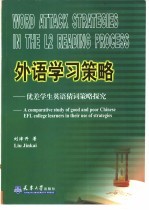

外语学习策略 优差学生英语猜词策略探究PDF电子书下载
- 电子书积分:10 积分如何计算积分?
- 作 者:刘津开著
- 出 版 社:天津:天津大学出版社
- 出版年份:2001
- ISBN:756181514X
- 页数:211 页
Chapter1 Key research questions and factors to be investigated 1
1.1 Definition of Word Attack Strategies(WASs) 1
1.2 Key research questions for the study 1
1.3 Factors to be investigated-A preview 1
1.4 A bird s-eye view of the remaining chapters 3
Chapter 2 Rationale of the present Study:A review of some representative theories of second language learning 5
2.1 An overview 5
2.2 Theory of language learning:A psycho-cognitive perspective 7
2.3 Vocabulary learning (VL)-A contextualized perspective 9
2.4 L2 learning process:An information-processing approach 12
2.5 L2 reading process:A cross-linguistic perspective 15
2.6 Aspects of L2 learning in which factors to be investigated Belong 26
Chapter3 Review of the related research literature of language learning strategies 28
3.1 Study of WAS as one of the Language Learning Strategies(LLSs) 28
3.2 Role of WASs in Vocabulary Learning(VL) 28
3.3 Role of WASs in reading 30
3.4 WASs and the reading context 31
3.5 Strategy transfer and training 33
3.6 Characteristics of good/poor L2 learners 35
3.7 Summary:the importance of effective meaning-guessing strategies that make use of context for word attack 39
4.1 Proposed approach to the study of WASs 40
Chapter4 Theoretical framework:A proposed approach to WAS study,research questions and research hypotheses 40
4.2 Factors affecting WAS use 43
4.3 Research questions 50
4.4 Research hypotheses 54
Chaptert5 Research design,instrumentation,and data collection 57
5.1 Pre-experiment typology of WASs 57
5.2 Subjects 57
5.3 Experiments 59
5.4 Pretests 62
5.5 Procedures 63
5.6 Statistics tools for data analysis 64
Chapter6 Results for the subjects effective use of WASs in terms of guessing scores 65
6.1 Measurement for guessing scores 65
6.2 Results for the effect of group learner differences upon guessing effectiveness 67
6.3 Results for the effect of task variation upon guessing effectiveness 70
6.4 Results for the effect of time upon guessing performance 74
6.5 Summary and comparison of the results 76
Chapter7 Results for the Subjects use of WAS types 78
7.1 Results for the Subjects use of WASs in terms of WAS types 78
7.2 Results for group learner difference in WAS type distribution 85
7.3 Results for task variance in WAS type distribution 85
7.4 Results for instrumental influence on WAS type distribution 89
7.5 Summary and comparison of the results 92
Chapter8 Results for the Subjects use of WASs in terms of effective and ineffective clues 94
8.1 Measurement for analysis of WASs-RW(Right/Wrong clue)scale 94
8.2 Results for group learner variance in right/wrong clue choice 95
8.3 Results for task variance in right/wrong clue choice 98
8.4 Results for the influence of the instrumental variable upon good/poor learner differences in right/wrong clue choice 99
8.5 Summary and comparison of the results 103
Chapter9 Results for the subjects choice of clues in relation to their guessing scores 104
9.1 Measurement for analysis of clue-choice in relation to guessing scores 104
9.2 Results for group learner variance in choice of cRNW 105
9.3 Relationship between cRNW and guessing scores 107
9.4 Differences between good and Poor students in terms of their guessing scores in relation to their clue choice 110
9.5 Language task variation in the subjects choice of cRNW and in the cRNW/guessing relationship 114
9.6 Summary of the results 118
Chapter10 Results for the subjects group characteristics in practice,exposure,attitude and guessing habits 120
10.1 Measurement for survey analysis 120
10.2 Group characteristics in L2:Good students vs.Poor students 121
10.3 Group characteristics in L1:Good students vs.Poor students 125
10.4 Gomparison of group characteristics:L2 vs.L1 129
10.5 Relationship between guessing habits in textbook reading and guessing habits in non-textbook reading 132
10.6 L2 and L1 variance in guessing habits,reading purposes and attitude 134
10.7 Relationship between survey items and clue choice 150
10.8 Relationship between survey items and guessing scores 154
10.9 Summary and comparison of the results 158
Chapter11 Interpretation of the results-Answer to the 4 key research questions 164
11.1 Similarities:All subjects L2 WAS use vs. their L1 WAS use 164
11.2 Good/poor learner differences in L2 WAS use 165
11.3 Factors related to good/poor learner differences in L2 WAS use 167
Chapter12 Conclusions,implications and recommendations 176
12.1 Conclusions 176
12.2 Limitations and recommendations 182
Appendix Ⅰ. Experiment Sheets(Experiment Version) 183
Appendixes 183
Appendix Ⅱ. Experiment Sheets(Non-experiment Version in English) 192
Appendix Ⅲ. Warming-up Exercises(Experiment Version) 203
Appendix Ⅳ. General WAS Type Distribution 204
Appendix Ⅴa. General WAS Type Distribution:L2 Tasks 204
Appendix Ⅴb. General WAS Type Distribution:L1 Tasks 205
Appendix Ⅴc. General WAS Type Distribution:Overall Tasks(L2+L1) 205
Appendix Ⅵ. General WAS Type Distribution(Weighted) 206
Appendix Ⅶ. General WAS Type Distribution(Weighted,Think-aloud Tasks Only) 206
References 207
- 《看漫画学钢琴 技巧 3》高宁译;(日)川崎美雪 2019
- 《信息系统安全技术管理策略 信息安全经济学视角》赵柳榕著 2020
- 《党员干部理论学习培训教材 理论热点问题党员干部学习辅导》(中国)胡磊 2018
- 《“十三五”规划教材 中药鉴定学实验 供中药学 药学及相关专业使用 第2版》吴啟南 2018
- 《事业单位招聘护士综合应试策略》杨会香,井秀玲,马小霞主编 2019
- 《晚清民国船山学的接受与传播》吴戬著 2019
- 《清代宋词学研究》曹明升著 2019
- 《深度学习与飞桨PaddlePaddle Fluid实战》于祥 2019
- 《全国普通高等中医药院校药学类专业“十三五”规划教材 第二轮规划教材 有机化学学习指导 第2版》赵骏 2018
- 《跟孩子一起看图学英文》张紫颖著 2019
- 《道家政治哲学发微》郑开著 2019
- 《在清华听的12堂财富课》严开著;张军良主编 2013
- 《在清华听的12堂修心课》严开著 2013
- 《在北大听的12堂管理课》严开著 2013
- 《在北大听的12堂经济课》严开著 2013
- 《教育改革之路》陈谟开著 2001
- 《教育管理之行》陈谟开著 2001
- 《教育发展之迹》陈谟开著 2001
- 《教育研究之知》陈谟开著 2001
- 《简历不简》叶无开著 2009
- 《大学计算机实验指导及习题解答》曹成志,宋长龙 2019
- 《大学生心理健康与人生发展》王琳责任编辑;(中国)肖宇 2019
- 《大学英语四级考试全真试题 标准模拟 四级》汪开虎主编 2012
- 《大学英语教学的跨文化交际视角研究与创新发展》许丽云,刘枫,尚利明著 2020
- 《复旦大学新闻学院教授学术丛书 新闻实务随想录》刘海贵 2019
- 《大学英语综合教程 1》王佃春,骆敏主编 2015
- 《大学物理简明教程 下 第2版》施卫主编 2020
- 《大学化学实验》李爱勤,侯学会主编 2016
- 《中国十大出版家》王震,贺越明著 1991
- 《近代民营出版机构的英语函授教育 以“商务、中华、开明”函授学校为个案 1915年-1946年版》丁伟 2017
